ARCHITOSH WAS INVITED TO BLUEBEAM LIVE in New Jersey a few weeks ago, and the event showcased enthusiasm from its users and commitment from its leadership to continue innovating.
In a sit-down interview with Usman Shuja, CEO of Bluebeam and Chief Division Officer Build & Construct, Nemetschek AG, along with Bluebeam co-founder Don Jacob, Chief Innovation Officer of Bluebeam, I heard an honest message that the company needed to get back to its core magic and push their solutions and innovations faster.
Customer Intimacy
“We have to admit that over the past few years, we have worked so hard on the transition to subscription that we lost touch with our customers,” admitted Usman Shuja, CEO, “so we are going to bring that back.” That was part of the point of this Bluebeam Live US and London tour, which for the US events took place in NFL league football stadiums like the MetLife stadium in New Jersey.

Bluebeam Live took place at MetLife Stadium in New Jersey as part of a US and UK roadshow hitting multiple cities.
The MetLife stadium matched the energy level of the Bluebeam Live event well, with the key hosts being the popular Construction Bros podcast brothers Tyler and Eddie Campbell. Their fun energy on stage instantly created a positive atmosphere of enthusiasm for attendees.
We have to admit that over the past few years, we have worked so hard on the transition to subscription that we lost touch with our customers, so we are going to bring that back.
As for “customer intimacy,” what that means is the Pasadena-headquartered software company knows its AEC customers well. “When I joined over a year ago, that was one of the things I noticed that helped make us successful,” says Shuja.
Subscription and Stickiness
This intimate connection to the Bluebeam customer has likely contributed to the software company’s success in transferring its user base from perpetual software licenses to new subscription licenses. Typically, in the CAD-based industries, such transitions have been challenging. Some companies have lost major customers over it. Others have launched “open letter” revolts. But in the case of Bluebeam, the transition has gone better than average.
Don Jacobs says that “stickiness has never been an issue with Bluebeam.” Part of that is Bluebeam is a much lighter lift than a costly BIM or CAD program. Another likely reason is that Bluebeam Revu doesn’t have any serious direct competition, but it does have competitors offering paradigm shifts to workflows that impact Bluebeam users. In this context, Bluebeam cannot rest on its laurels but instead must deepen its value to customers by solving their problems.
A Brief History
Founded in 2002, Bluebeam initially made a name for itself by developing PDF-based solutions for the AEC market. Its flagship product, Bluebeam Revu, gained massive popularity in US construction for its powerful PDF markup, measurement, and collaboration features, which helped AEC professionals coordinate construction documents and manage collaboration workflows.
Nemetschek of Germany acquired Bluebeam in 2014, adding it to its portfolio of architecture, engineering, and construction (AEC) industry software companies operating globally. In 2016, Bluebeam launched a native macOS version of its flagship Revu product to address the rising popularity of Apple’s MacBook laptop computers. However, in March of 2019, Architosh was given the exclusive that Revu for Mac was being discontinued in favor of concentrating future development on Bluebeam solutions in the cloud.
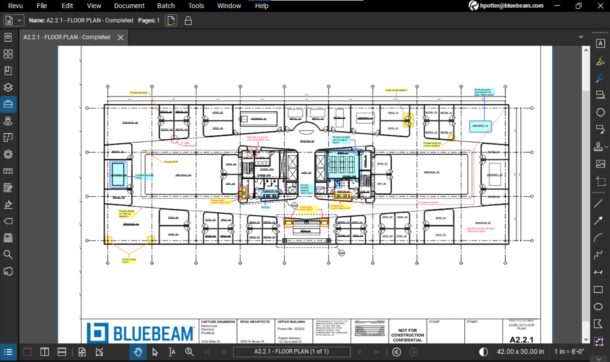
Revu is Bluebeam’s flagship and original software application that runs on Microsoft Windows (X86) computers. With Windows on ARM chip computers expected to reach 50% of all mobile laptops in five years, there is some discussion about a native version for Windows on ARM, but no firm commitments just yet.
The cloud became increasingly important in AEC software companies in the last few years of the previous decade. In response to the rapid rise of Procore, Autodesk acquired the cloud app PlanGrid in late 2018, as the construction industry shifted towards cloud-based solutions. Bluebeam’s pivot to the cloud was all but assured, but its flagship Revu software—which runs as a Windows desktop app—has already leveraged real-time interconnected collaboration capabilities via its Studio Sessions features. In some sense, Bluebeam was already leveraging the cloud but not through the framework of a web browser-based application.
Bluebeam’s plans for a web-browser-based cloud version were kept close to its chest, but in 2021, Project Rover was released to select users. In 2022, Rover would become Bluebeam Cloud.
Meanwhile, from 2019 to the present, Bluebeam has continued to grow beyond its strong US-based construction industry market. Outside of the United States, Bluebeam has a powerful presence in Australia, the UK, Scandinavia, and the DACH regions of Europe. Still, during these same years, fully cloud-based platforms like Procore and Autodesk Construction Cloud have continued to grow in utilization.
So what did I learn at Bluebeam Live about the future of Bluebeam?
Bluebeam’s Product Strategy
Bluebeam Cloud is evolving around three primary focuses. The first one is Bluebeam Studio Sessions. The second one is Bluebeam Projects. And the third one is about markups and sharing PDFs—no matter where they are located—through the web and mobile using many of the same tools and features users love in Revu. Here is what Don Jacob, Chief Innovation Officer and co-founder of Bluebeam, told me during the MetLife Stadium interview.
When asked about the recent big changes with Bluebeam Cloud, Jacob remarked: “We are focusing on the fundamentals—in the cloud and in mobile. And we will aggressively be adding features [to those solutions] first and foremost around markup and the ability to interact in Sessions.”
Bluebeam Cloud received a significant update in Q3 of this year. All of the field-based features like Punch and RFIs were removed from the application. Instead, those features will come back later after Bluebeam and the recent Nemetschek acquisition, GoCanvas, coordinate their mutual efforts. (more on GoCanvas later). “In the job site trailer, you will have your Studio Sessions,” adds Jacob, “but on-site, you will use a new type of tool powered by GoCanvas.”
The New Bluebeam Cloud
The new Bluebeam Cloud will have two significant areas—Studio and Projects. Studio is where you hold all your Studio Sessions. Today, it is possible to start a Studio Session from Revu or Bluebeam Cloud via a Mac or PC web browser. Bluebeam’s extremely popular Studio Sessions collaboration capabilities now extend to anybody with a web browser on any computer to the Bluebeam Cloud app on a smartphone.
“Studio Sessions is that virtual collaboration area,” says Jacob. “It has a time element to it; when you start a session, it would typically exist for two weeks.” Studio Sessions are powerful, and the newly added “anywhere on any device” capabilities just made them more valuable. “The Sessions paradigm is about collaboration,” says Jacob. “We have some customers who keep Sessions open for years.”
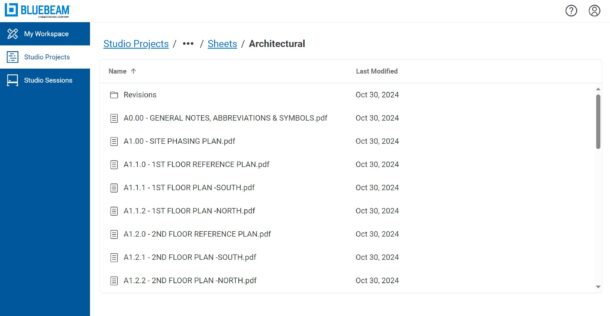
Bluebeam Projects is the latest update to Bluebeam Cloud, following the addition and support of Bluebeam Sessions earlier this year.
Projects is also part of Bluebeam Cloud. “Think of Projects as that data repository,” adds Jacob. “You load your drawing sets into that, and you can then access them from multiple platforms now.” Bluebeam Projects differ from Studio Sessions based on time. Whereas Sessions have a time limit imposed on them, Projects have permanence. They are never archived or deleted automatically.
Projects in Bluebeam Cloud present a single source of truth (SSoT) with data and offer users a folder-tree-based file structure for document management. File support goes beyond PDF and includes Microsoft Office formats, images, video, and more. In essence, Projects in Bluebeam Cloud act like a common data environment (CDE) with version control, access control, file sharing with security settings, and integration with Sessions capabilities. And there is more. For a more detailed explanation of Sessions versus Projects, readers can find details on this linked page here.
Revu in the Cloud (?)
A third aspect of Bluebeam Cloud is Revu functionality. Many are wondering—especially those Mac Revu users from years ago—if all of Revu’s functionality will be reproduced in the Bluebeam Cloud.
When I asked Jacob, he replied: “All is a big word. When you think of cloud versus desktop, certain things make sense, for each. With cloud, you have automation capabilities, and there are 20 years of features in Revu.” The reading of the tea leaves part of that statement notes that users—especially those on macOS—should not expect full Revu functionality inside Bluebeam Cloud in the foreseeable future.
Still, Luke Prescott, Senior Director of Product at Bluebeam, whom I also met at Bluebeam Live, sat down with me to explain the details and the company’s thinking. “Certainly, the goal is to get the most important features of Revu also into Bluebeam Cloud as soon as possible,” added Prescott. As Jacob noted, that will begin with the fundamentals of markup.
A third area of Bluebeam Cloud is allowing the web-based application to be utilized for PDF markup outside of Bluebeam Projects or Bluebeam Studio Sessions. Doing that might appeal to a broader array of customers both in and outside AEC. Small practice professionals may want a markup tool for redlining CAD and BIM output as well as managing shop drawings from contractors and subs. And non-AEC customers may want a cloud PDF markup tool that happens to have things like arrows, dimension markers and bubble clouds.
Of these three areas of focus for the cloud strategy at Bluebeam, Projects and Studio Sessions are much more important.
Answering the What About’s
So what about the Mac? Despite the fact that Apple has nearly doubled its market share since 2020 when Apple Silicon was introduced, the 2019 decision against Revu for the Mac stands. Revu on Windows will continue to evolve, but all other development efforts are focused on cloud and mobile.
On a side note, Luke Prescott told me that Bluebeam is aware of the new Windows on ARM laptop computers and is watching the industry closely. If Windows on ARM explodes—and with Nvidia entering the PC market next year with an ARM SoC, it could—there is a chance an ARM rewrite of Revu could take it back to the Mac as well. For now, this is all hypothetical.
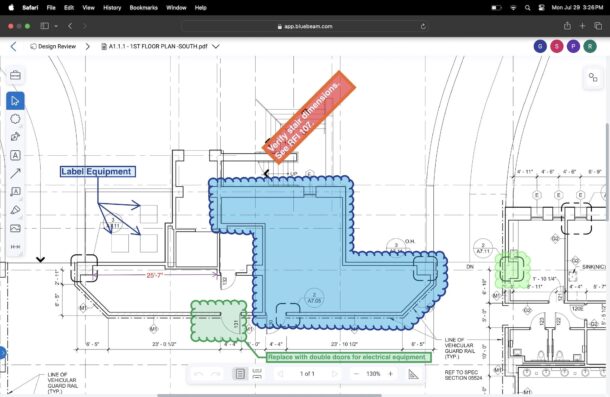
Bluebeam Sessions are the popular collaboration technology found in Revu. Now Sessions are supported from Bluebeam Cloud enabling Sessions participants to collaborate from Mac computers as well as Windows devices. Here is a screenshot of a Session from inside Apple Safari on the Mac.
Bluebeam users past and present reading this may have questions. Prescott helped answer them for me, and we’ll share them with you now.
For example, those using the very latest Bluebeam Cloud will have questions. At the moment, Bluebeam Cloud lets you upload new PDF drawings for Sessions, yet there has yet to be an upload feature for Projects. The only way to add drawings for Projects is through Revu on the desktop. Prescott says this will change soon.
In a similar vein, Projects on Bluebeam Cloud supports setting drawing scaling so you can do accurate drawing measurements. But it doesn’t do the select “two-point calibration” scaling as Revu does. They are working on that as well.
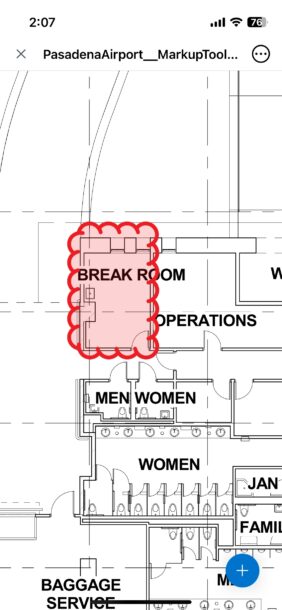
Mobile devices and their participation in all aspects of Bluebeam are critical to the company enabling field workers on construction sites to take the power of Bluebeam to any point on the job site. GoCanvas is a big part of the future of field tech for Bluebeam.
Getting back to Revu functionalities in Bluebeam Cloud, Prescott says they know users will want as many Revu capabilities in cloud and mobile as possible, and they will respond to their users. Stamps and things like Drawing Compare are all on the to-do list. Today, Bluebeam Cloud supports the Tool Chest, but more advanced features with Tool Chest are also coming, and users can influence future development through the Bluebeam Community.
And regarding those field features ripped out of Bluebeam Cloud? Prescott says that figuring out how those features will come back will take some time as they work on integration plans with GoCanvas.
GoCanvas
GoCanvas —Nemetschek Group company—is a purpose-built mobile data platform initially designed to eliminate paper forms. Instead, end-users gain the ability to create digital versions of forms on smartphone or tablet apps. Industries covered include construction, manufacturing, oil and gas, and transportation.
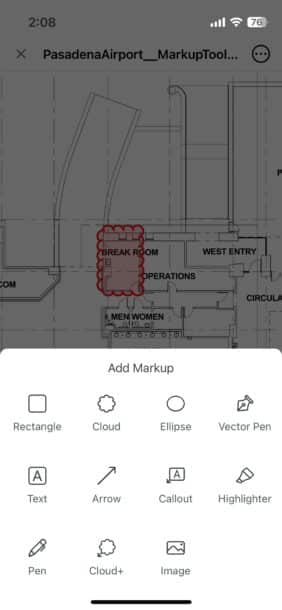
The iOS version of Bluebeam Cloud can support all the typical markups plus features like images from the iPhone’s camera.
On the AEC side, GoCanvas has popular solutions for field services and workflows, including landscaping, HVAC, plumbing, electrical, roofing, and fire and life safety. The GoCanvas acquisition looks pretty smart when paired with Bluebeam.
Field activities on construction sites include architect and engineer site reviews, dedicated punch list workflows, and site superintendent walkthroughs for quality control, among many other reasons.
GoCanvas boasts the ability to make custom form creation and custom reports easy. It doesn’t take that much imagination to understand how API integrations with GoCanvas could lead to new punch and RFI tools that integrate into Bluebeam or are part of the Bluebeam ecosystem but based on GoCanvas technology.
Synergy and Final Comments
Bluebeam seems to have its cloud strategy more firmly rooted, and Jacobs and Prescott both promised users would see more frequent updates, not just to the cloud but also to mobile.
For Shuja, Bluebeam’s CEO, five major strategic elements are driving the company forward. The first is interoperability and integrations. The second element is interlinking field and office workers. Bridging the gap between the field and office worker and bringing site intelligence to the office is part of the GoCanvas acquisition story.
The third element is intelligent drawing and collaboration through leveraging trusted AI. The fourth strategic element of Bluebeam’s future is to inspire the next generation of Bluebeam fans. This is about delivering the promise of Bluebeam Anywhere, by investing in cloud, mobile, and modern UX to delight users, especially younger users.
The cloud and mobile are a key part of the next generation and having a very slick and modern experience with PDF technology is also a part of this strategy.
Finally, the fifth element is internationalization. The goal is to take the trusted Bluebeam workflow experience to the rest of the world.
In terms of integrations and data interoperability, the recent Autodesk + Nemetschek API agreement is also a critical step. Through the efforts of a key mutual partner, there is a new ACC to Bluebeam connector so Autodesk Construction Cloud (ACC) users can initiate Bluebeam Studio sessions directly from within ACC. (see: Architosh, “ARKANCE unveils Bluebeam to ACC Connector,” 1 Nov 2024)
“How do we inspire the next generation of users?’ asks Shuja, rhetorically. “The cloud and mobile are a key part of the next generation and having a very slick and modern experience with PDF technology is also a part of this strategy.”
Shuja recognizes that only through leveraging best-of-breed tools from multiple software vendors can the industry deliver more optimized outcomes. “Philosophically, we want to bring the industry together,” he says. “We can solve big problems only together. The point isn’t to work with everyone just because, but because our customers are asking us to solve big problems that require bringing solutions together.”




